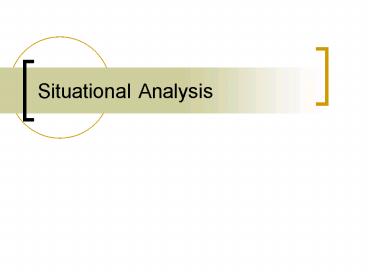Situational Analysis - PowerPoint PPT Presentation
1 / 16
Title:
Situational Analysis
Description:
A challenging exercise; one of the most difficult parts of the marketing plan ... Retailer strategy: Banana Republic, Gap, Old Navy. Political Trends ... – PowerPoint PPT presentation
Number of Views:1610
Avg rating:3.0/5.0
Title: Situational Analysis
1
Situational Analysis
2
Conducting an environment (or) a situation
analysis
- A challenging exercise one of the most difficult
parts of the marketing plan - Should provide a complete picture of three key
environments - Internal,
- Customer, and
- External
3
Layers in a situation analysis
This macro level is not controllable and usually
affects the entire industry
4
The Internal Environment (1 of 3)
- Review current objectives, strategy and
performance - An important input to later stages in the
planning process - Poor or declining performance must be the result
of - Goals or objectives that are inconsistent with
customer or external environments - Flawed marketing strategy
- Poor implementation
- Changes in the customer or external environment
beyond the control of the firm
5
The Internal Environment (2 of 3)
- Availability of Resources
- Includes review of financial, human and
experience resources as well as resources from
key relationships - Financial resources tend to get most attention
- Labor shortages are expected to be a major
problem in the coming years - Projected shortfall in human resources
- U.S. Dept of Labor predicts 22 M new jobs by 2010
- However, civilian labor force is expected to
increase by only 17 M - Fast food, services, nursing, retail, computer
support will be hardest hit
6
The Internal Environment (3 of 3)
- Organizational Culture and Structure
- Problems can arise when marketing does not hold a
prominent position in the political hierarchy - Culture and structure are relatively stable but
can be affected by mergers - Asynchronous corporate mergers
- Daimler- Chrysler Merger
- HP-COMPAQ
7
The Customer Environment
- Who are our Current and Potential Customers?
- What do our Customers do with our Products?
- Where do Customers Purchase our Products?
- When do Customers Purchase our Products?
- Why (and How) do Customers Select our Products?
- Why do Potential Customers not Purchase our
Products?
8
The External Environment (1 of 4)
- Competition (4 Major Levels)
Total Budget consumer dollar
Generic fulfill general need
Product brands in product class
Brand Direct competitor
9
Levels of Competition
Ice cream
Beer
Regular colas
Wine
Diet lemon limes
Juices
Diet Diet Coke Pepsi
Fast food
Video rentals
Brand diet colas
Fruit flavored colas
Lemon limes
Product category soft drinks
Bottled water
Coffee
Generic competition beverages
Baseball cards
Budget competition food and entertainment
Source Donald R. Lehmann and Russell S. Winer,
Product Management, 1997
10
Stages of Competitive Analysis
- Identify all current and potential competitors
- Brand, product, generic, and total budget.
- Assess each key competitor
- Size, growth, profitability, objectives,
strategies, and target markets. - Assess each key competitors strengths and
- weaknesses.
- Capabilities and vulnerabilities in different
functional areas - Focus the analysis on each key competitors
- marketing capabilities.
- In terms of product, price, place, and promotion
- Estimate each key competitors most likely
- strategies and responses under different
- environmental situations.
11
The External Environment (2 of 4)
- Economic Growth and Stability
- In U.S the size of upper-income class has
increased, middle income remained mostly stable,
lower-income declined - Discretionary income has supported growth of
bottled water, Godiva chocolates - Average savings have declined (43 wont have
enough for retirement. Link) - Retailer strategy Banana Republic, Gap, Old Navy
- Political Trends
- Elected political officials influence taxes,
Tobacco industry, Recycling, antitrust cases
12
The External Environment (3 of 4)
- Legal and Regulatory Issues
- Emphasis on natural environment has forced
companies to become more green - Increased rigor in corporate accounting and
reporting (Sarbanes-Oxley Act) to limit corporate
and accounting scandals involving prominent
companies in the United States. - Has resulted in a surge of hiring of auditors and
increased business for consulting firms - NAFTA (North American Free Trade Agreement)
prompted diversification into Canadian and
Mexican markets I-35 high priority - Technological Advancements
- Influence of the Internet on all aspects of
marketing including product/production,
communication, pricing, promotion, channels - Trends in biological research have led to better
drugs and medicines, disease resistant crops,
genetically modified foods - RFID (Radio Frequency Identification)
13
The External Environment (4 of 4)
- Sociocultural Trends
- Demographic Trends
- Lifestyle Trends
- Trends in Cultural Values
14
Examples of Trends in theSociocultural
Environment
- Demographic Trends
- Aging of the American population
- Fighting aging skin care, adventure vacations,
health foods - Increasing demand for health care, hospitals,
senior lifestyle providers - Increasing population diversity
- Bi-lingual signs, salespeople Support community
programs - Cosmetics firms need to cater to different
audiences - Population growth in the Sun Belt states
- Demand for homes, support services, appliances
like ACs - Lifestyle Trends
- Clothing has become more casual, especially at
work - Growing focus on health and nutrition Organic
produce vegetarianism - Time spent watching television has declined
- Trends in Cultural Values
- Less focus on me-oriented values
- Increasing importance of family and children
15
Age Distribution in U.S.
Generational Cohorts
Baby Boomers (82 million people born
1946-1964) Generation X (45 million
people born 1965-1976) Generation Y (Echo
Boomers) (72 million people born 1977-1994
Woodstock, Kennedy Assassination, Vietnam
Divorce, AIDS The MTV generation more cynical
honesty and irreverence in advertising
The Internet, 9/11 Relate well to causes teen
markets
Events occurring when people first became
economic adults (usually ages 17 21) and its
affect on their lifelong attitudes and values.
16
Supporting Marketing Decisions
Training and motivating the sales force
Motivating channel members to
share info
Buying info from commercial data
sources
Improving the quality of marketing intelligence
Collectingcompetitive intelligence
Developing a customer advisory panel
Establishing a marketing information center































